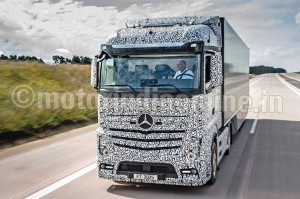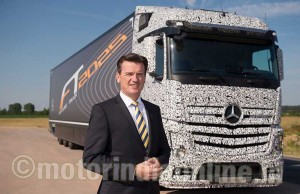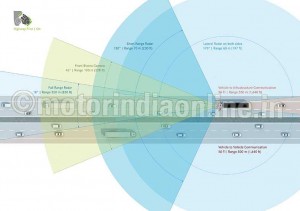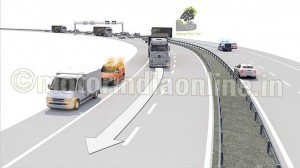World’s first self-driving transport vehicle
 Mercedes-Benz presents the “Future Truck 2025” as the world’s first autonomously driving truck – a truck driving along a motorway all by itself at a speed of 80 km/h, communicating with its surroundings and ensuring more safety on the roads. It also saves its operator money and relieves its driver of stress and fatigue in monotonous traffic conditions.
Mercedes-Benz presents the “Future Truck 2025” as the world’s first autonomously driving truck – a truck driving along a motorway all by itself at a speed of 80 km/h, communicating with its surroundings and ensuring more safety on the roads. It also saves its operator money and relieves its driver of stress and fatigue in monotonous traffic conditions.
Sounds like science fiction? Think again, as it is already here today – the Future Truck 2025 from Mercedes-Benz. The Highway Pilot system enables this truck to drive autonomously at a speed of 80 km per hour. With it the company is presenting the long-distance truck of tomorrow, and giving an outlook on the transport system of the future. It is based on intelligent networking of all the safety systems already available, plus cameras, radar sensors and vehicle-to-vehicle communication.
There are many challenges facing the road transport sector. Despite increasing traffic density, investment in the infrastructure is on the decline. Added to this are the increasing cost pressure on transport operators and the already acute shortage of drivers. Daimler Trucks has an answer to all this – the truck of tomorrow: safer, more efficient, highly networked and autonomous.
Thanks to autonomous driving, the transport sector could look like this in only 10 years: Traffic flows are smoother, more predictable and safer. Human error behind the wheel is avoided. Freight forwarders operate more profitably and flexibly. The professional profile of the truck driver has undergone a change, from a trucker to a transport manager with far more responsibilities.
Hard to believe? “Then take a look at this Special, where we have put together everything worth knowing about the Future Truck 2025 for you. And from tomorrow you can see it in ‘autonomous action’” – in a recording of the world premiere run on a section of the A 14 autobahn near Magdeburg.
Why autonomous driving?

Is there a danger of gridlock in the future? Nobody can be certain. But experts agree on one contributing factor: forecasts for the future development of goods traffic in Europe suggest that it will increase considerably.
The technological basis for the Future Truck 2025 with “Highway Pilot” is the Mercedes-Benz Actros 1845.
Innovations of the Future Truck 2025
The technical features are decisive for the outstanding capabilities of the Mercedes-Benz Future Truck 2025 as an autonomous vehicle – interplay of connectivity, efficiency and security. With its “Highway Pilot” system, it is an intelligently conceived and realistic response to current developments. It communicates with its environment and drives autonomously.
Already today, drivers are supported by comfortably equipped, climatised cabs, assistance systems such as Proximity Control Assist, Stop-and-Go Assist and fully automated transmissions.
As for legal requirements and time horizon for autonomous driving, the stages leading from manual to autonomous driving must be flanked by legal provisions. Legislation needs to be adapted to this new dimension in driving. It’s leading the way in assistance and safety systems in the sense that autonomous driving builds on the available assistance systems as a logical further development, and consolidates their capabilities.
The Future Truck 2025 pays attention and makes room
 The traffic of tomorrow will likewise have its share of unforeseen incidents and breakdowns, occasionally slow down and come to a stop, but the Future Truck 2025 smoothly adapts to the conditions. A message appears in the display: “Emergency vehicle approaching”. The information comes from a police car, by V2V communication. The communication between vehicles works perfectly, the truck automatically moves over to the right until it reaches the lane marking, clears the way for the fast-moving police car and then returns to the centre of its lane.
The traffic of tomorrow will likewise have its share of unforeseen incidents and breakdowns, occasionally slow down and come to a stop, but the Future Truck 2025 smoothly adapts to the conditions. A message appears in the display: “Emergency vehicle approaching”. The information comes from a police car, by V2V communication. The communication between vehicles works perfectly, the truck automatically moves over to the right until it reaches the lane marking, clears the way for the fast-moving police car and then returns to the centre of its lane.
Meanwhile the driver remains in his working position and merely observes the scene and uses Skype to answer an enquiry from a colleague travelling well behind about the cause of the delay. Because the ‘Highway Pilot’ is able to announce a broken-down vehicle ahead in advance. It is stationary on the emergency lane, so the truck automatically moves left to the centre-line and passes the broken-down vehicle while keeping a safety distance, as it also has its eye on the traffic in the left lane. After passing the obstacle, the truck returns to the right-hand lane and accelerates back to its cruising speed.
Overtaking is manual, the driver retains control
Minutes later the display reports a slow-moving vehicle ahead. In autonomous mode the Future Truck 2025 would patiently follow the slow-mover, as it never leaves its lane. But in this case overtaking is worthwhile, owing to the large difference in speeds. So the driver pivots the seat into the driving position, takes over manual control, indicates and changes lane to overtake. Returning to his lane, he can then hand control back to the “Highway Pilot”. Important note: The driver of the autonomous truck is always in full control, and can always override the technology by steering, braking or accelerating as required.
Plan the next tour while on the move
 There are more important things to do than manually keep pace in a convoy of trucks: the tablet reports another assignment, this time with a refrigerated semitrailer. Once again V2I communication comes into its own: an app is used to activate the trailer’s refrigeration unit directly from the tablet, and it is pre-cooled at exactly the right time. When the driver arrives to pick up the trailer, it will be at just the right temperature.
There are more important things to do than manually keep pace in a convoy of trucks: the tablet reports another assignment, this time with a refrigerated semitrailer. Once again V2I communication comes into its own: an app is used to activate the trailer’s refrigeration unit directly from the tablet, and it is pre-cooled at exactly the right time. When the driver arrives to pick up the trailer, it will be at just the right temperature.
But there is still time for a break beforehand: the vehicle is approaching the chosen service station. In good time the “Highway Pilot” announces the exit road on the tablet and display, then starts a countdown for the driver to take over the necessary manual control. A welcome break: the reserved parking space is available, and the pre-ordered meal is on the dining table in the service station right on time. All perfectly normal in the Mercedes-Benz Future Truck, and in 2025.